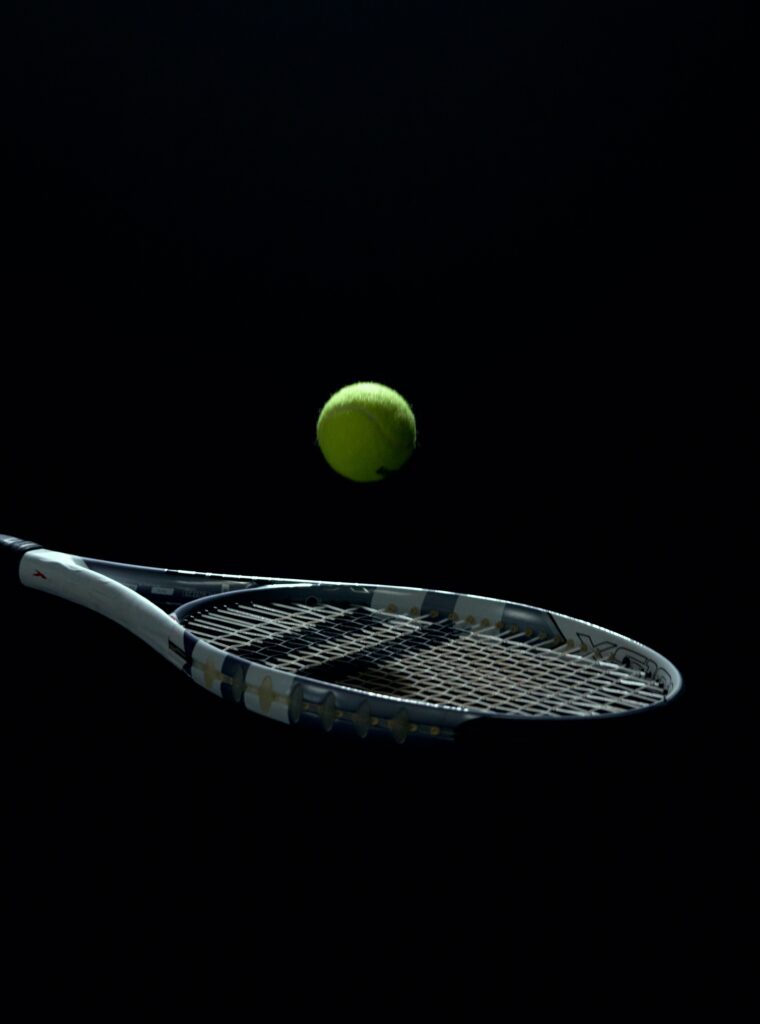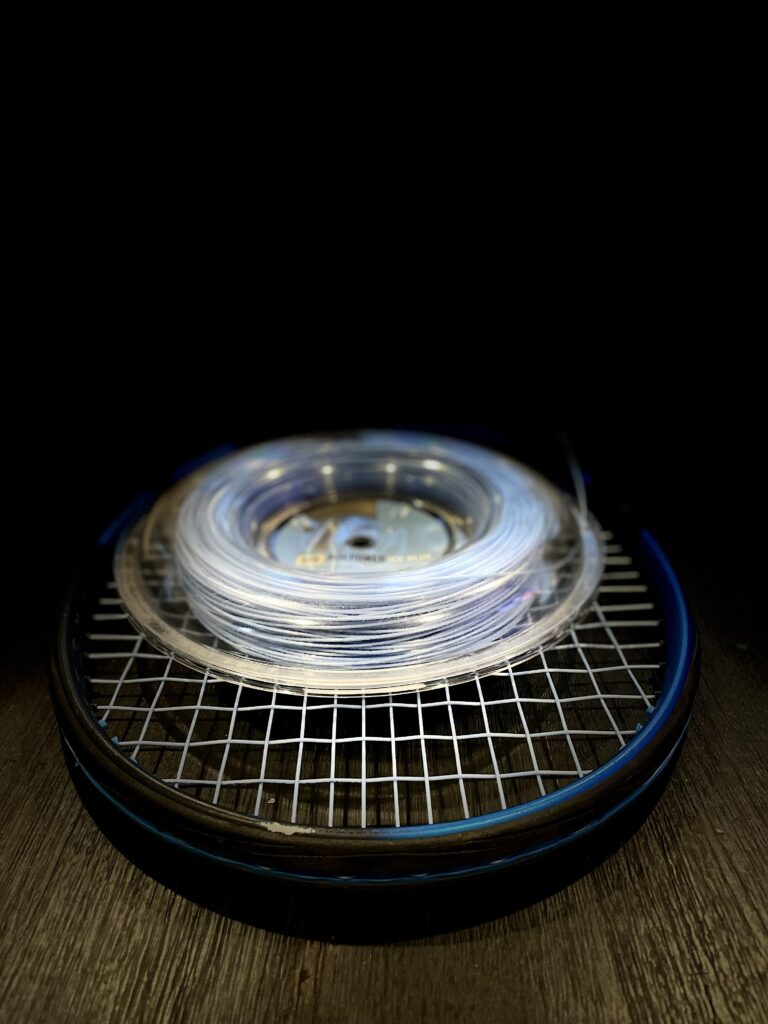
- String tension affects power, control and spin in tennis.
- Playtime, storage and environmental factors impact string tension.
- Lower tension yields power, while higher tension offers control and precision.
- Apps like the RacquetTune or Tennis Vibes offer accurate smartphone-based tension measurement.
- Professional players select tension based on playing style and personal preferences.
- String tension plays a pivotal role in tennis performance and can be managed effectively.
When it comes to tennis, every player wants to get the most out of their equipment to elevate their performance. One crucial, often overlooked aspect of your tennis racket setup is string tension. In this guide, we’ll explore the ins and outs of tennis string tension, explaining why it matters, how to measure it, and how to choose the best tension for your game.
Tennis string tension refers to the force with which your racket’s strings are pulled during the stringing process. It’s typically measured in pounds or kilograms. The tension in your strings can significantly impact your gameplay, affecting aspects like power, control, and spin. Let’s dive into the key factors to consider.
The Science behind String Tension

String tension primarily influences two essential aspects of your game:
- Power vs. Control: Higher string tension (above 55 pounds) tends to provide better control and precision in your shots. On the other hand, lower string tension (below 55 pounds) generates more power. This may sound counterintuitive, but it is due to the “trampoline effect” of the strings. Lower tension allows the strings to deform more, store energy and then release it during your swing creating a “pop” effect during impact.
- Spin: Lower tension also allows for more string movement, which aids in generating spin. So, if you’re looking to add more spin to your shots, you might consider lowering your string tension.
Factors Affecting String Tension
Several factors can influence your racket’s string tension over time. Playtime, time between restringing, exposure to hot weather, or leaving your racket stored in a bag can cause tension to decrease gradually. It’s crucial to reevaluate and adjust your tension periodically to maintain optimal performance.
How to Measure String Tension
To optimize your string tension, you need to know what tension your racket currently has. Here’s a simple way to measure it:
- Tension Gauge: You can purchase a tension gauge, a handy tool for measuring string tension. Place it between the strings, and it will display the tension.
- Professional Stringer: Take your racket to a professional stringer who can measure and adjust the tension accurately.
- Smart phone apps like RacquetTune or Tennis Vibes that allow you to measure string tension yourself. These tools can be a game-changer for players looking to fine-tune their tension preferences.
Choosing the Best Tension for Your Racket
The optimal string tension varies from player to player, depending on your playing style and skill level. Here’s a breakdown:
- Beginners: Beginners and kids often benefit from lower tension (around 50-55 pounds) because it provides more power with less effort and are easier on the arm and elbow.
- Intermediate Players: Intermediate players can experiment with a tension range of 50-60 pounds to find the balance between power and control that suits their playing style.
- Advanced Players: Advanced players tend to prefer higher tension (above 60 pounds) for added control and precision, especially if they generate their power.
- Consider Your Playing Style: Think about whether you’re more of a baseline player, serve-and-volley specialist, or an all-court player. Your style can influence your ideal tension.
- String Type: The type of strings you use (polyester, synthetic gut, natural gut) can also impact your preferred tension. Experiment with different combinations to find the best fit.
Professional Tennis Players String Tension Preferences
Professional tennis players often have personalized string tension preferences. It varies based on their playing style, racket choice, and personal preferences. For instance, some players like Roger Federer prefer lower tension to maximize power and spin, while others like Casper Ruud opt for higher tension for precision and control.
String Tension Tips

- Experiment: Don’t be afraid to experiment with different tensions to find what works best for you. It may take some trial and error.
- Consistency: Once you find your ideal tension, try to maintain it consistently for optimal performance.
- Consider External Factors: Keep in mind that external factors like temperature and humidity can affect tension. Adjust as needed.
- Reevaluate: As you progress in your tennis journey, your playing style may change. Periodically reassess your string tension to ensure it aligns with your current game.
In conclusion, understanding and optimizing your racket tension can have a significant impact on your performance. Whether you’re seeking more power, control, or spin, the right string tension can make a world of difference. Experiment, measure, and fine-tune your tension to elevate your tennis game to new heights.
Remember, the best tension for your racket is a personal choice that depends on various factors. So, go ahead, take your racket to a professional stringer, download a string tension measurement app and start fine-tuning your game today.
Optimizing your tension is just one piece of the puzzle in becoming a better tennis player. Keep practicing, stay consistent, and enjoy the game!
Frequently Asked Questions (FAQs)
How often should I restring my tennis racket?
It depends on your playing frequency. On average, restringing every 3-6 months for regular players is recommended.
Can string tension affect my tennis elbow risk?
Yes, tension can impact arm comfort. Lower tension may be gentler on the arm, potentially reducing the risk of tennis elbow.
What’s the ideal tension for a power-oriented playing style?
Players seeking more power may benefit from lower tension, typically around 50-55 pounds.
How do I measure string tension with a smartphone app?
Download a tension-measuring app like “StringMeter,” follow the instructions, and place it between your strings to get the tension reading.
Should I consider string type when selecting tension?
Absolutely. The type of strings (polyester, synthetic gut, natural gut) should complement your tension choice and playing style.
Can extreme weather conditions affect string tension?
Yes, hot weather can cause strings to lose tension more rapidly. Consider restringing more frequently in such conditions.
What’s the tension range recommended for all-court players?
All-court players often find their sweet spot in the 50-60 pounds range, balancing power and control.
How does string tension affect topspin and slice shots?
Lower tension allows for more string movement, aiding in generating topspin. Higher tension can provide better slice control.


